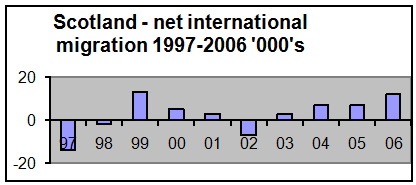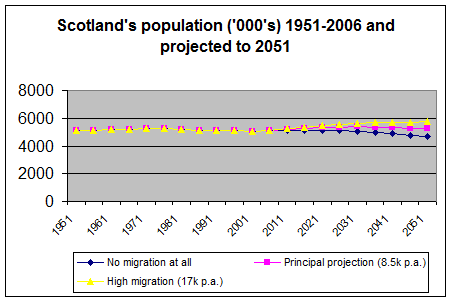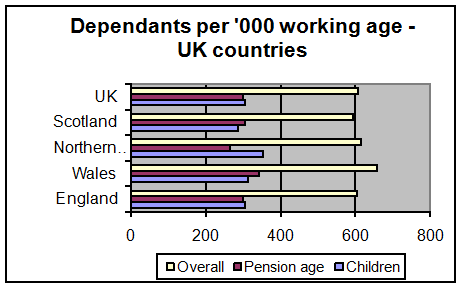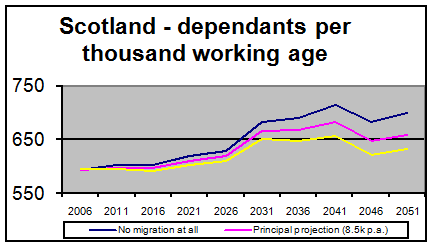Does Scotland Need Immigration?
1 September, 2008
Summary1. Scotland’s population is not declinin&g. As in all developed countries, it is ageing but immigration as a solution to a pensions problem has been dismissed by all serious studies. The economic claims for large scale immigration have been conclusively rejected by the Economic Affairs Committee of the House of Lords after a major investigation; similar considerations apply to Scotland. A limited category in a Points Based Scheme should be quite sufficient. A separate immigration regime for Scotland would be both unenforceable and ineffective.
Introduction
2. It is often suggested that Scotland needs immigration because of its declining and ageing population and because the economy needs immigrants to revitalise it. These claims are considered below.
The scale of immigration to Scotland
3. It is important to realise that international migration to Scotland has been extremely small compared to that to England. In the ten years to 2006, the total flow to Scotland was 27,000 compared to 1.57 million to England. Put another way, less than 1/4 of one per cent of net foreign immigration to the UK has been to Scotland. Allowing for the fact that the population of England is 10 times that of Scotland, the flow of immigrants to England is still six times higher than to Scotland. The foreign born population of England at 9.3% is nearly two and a half times the 3.8 % for Scotland[1]. England’s population density is about six times higher than Scotland, although a higher proportion is habitable.

Population
4. Scotland's population has been about 5 million for the past 50 years and will remain at that for the next 25 years even without net migration. The diagram below shows that, on the principal projection, Scotland's population will increase slightly until the middle of this century. The immigration assumption behind that projection is that net international immigration will be 4,000 per year and internal migration (mostly from England) will be a net positive of 4,500 per year.

An ageing population
5. Scotland is not a “special case”. Indeed it is, at present, slightly better placed than England as the following bar chart indicates:

6. Immigration makes relatively little difference to the number of dependants per 1,000 of working age. As the following graph shows, the difference, in mid century, between no migration at all and the principal projection is between about 660 and 700 dependants per 1,000 of working age, or about 6 %.

7. In any case, immigration as a solution to the pensions problem has long been dismissed by experts. Most recently, the House of Lords Select Committee on Economic Affairs concluded that "Arguments in favour of high immigration to defuse "the pensions time-bomb" do not stand up to scrutiny as they are based on the unreasonable assumption of a static retirement age as people live longer and ignore the fact that, in time, immigrants too will grow old and draw pensions. Increasing the official retirement age will significantly reduce the increase in the dependency ratio and is the only viable way to do so". [2]
Economic Benefits
8. It is also argued in Scotland that immigrants are needed to fill vacancies. The House of Lords Economics Committee concluded, however, that "Because immigration expands the overall economy, it cannot be expected to be an effective policy tool for significantly reducing vacancies. Vacancies are to a certain extent, a sign of a healthy labour market and economy. They cannot be a good reason for encouraging large-scale labour immigration".[3]
9. It is also suggested that immigrants are needed to do jobs that Scots will not do. Again, this was dismissed by the House of Lords Economic Committee who concluded that "The argument that sustained net immigration is needed to fill vacancies, and that immigrants do the jobs that locals cannot or will not do, is fundamentally flawed. It ignores the potential alternatives to immigration for responding to labour shortages, including the price adjustments of a competitive labour market and the associated increase in local labour supply that can be expected to occur in the absence of immigration"[4]
10. Finally, it is claimed that Scotland needs the dynamism provided by immigrants. The House of Lords was unconvinced. They concluded that “Although possible in theory, we found no systematic empirical evidence to suggest that net immigration creates significant dynamic benefits for the resident population in the UK. This does not necessarily mean that such effects do not exist but that there is currently no systematic evidence for them and it is possible that there are also negative dynamic and wider welfare effects.”[5]
A special scheme for Scotland?
11. A start has been made in this direction through the "Fresh talent: working in Scotland Scheme" recently introduced. However, no such scheme could be enforced unless immigration controls and a physical barrier were to be put in place - reinforced perhaps by maritime patrols and the inspection of vehicles and trains. This only has to be stated to be dismissed as impractical.
12. In the absence of immigration controls, there is clearly a risk that many of those admitted for work in Scotland would head South for higher wages, a warmer climate and, often, compatriots already in England. The area of destination in the UK could be factored into a Points Based System but it would have to be on a very limited scale. Otherwise the net result would be a back door to England which provided little or no benefit to Scotland. (Australia, which has a regional dimension to its immigration regime, also has a facility for employers to check on line the immigration status of applicants).
Conclusion
13. There is no significant economic case for large scale immigration to Scotland. A separate immigration system that such a policy would require would be unenforceable, ineffective and undesirable.
Footnotes
| [1] | 2001 census |
| [2] | HL Paper 82-1 "The Economic Impact of Immigration", para 158 |
| [3] | IBID para 104. |
| [4] | IBID, para 122. |
| [5] | IBID, para 216. |
